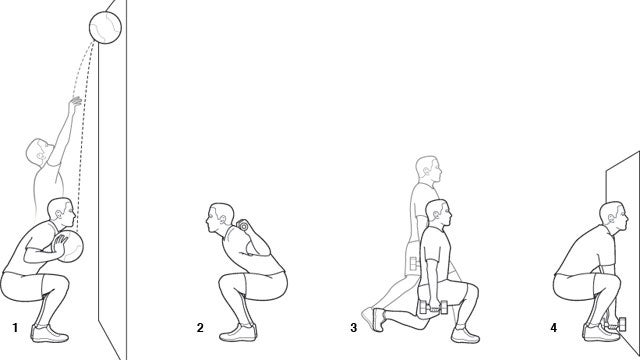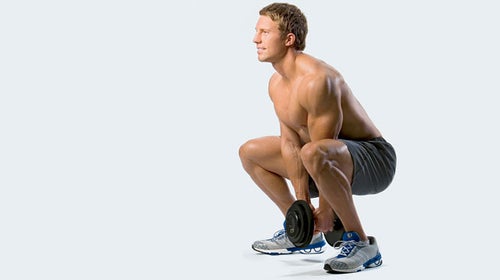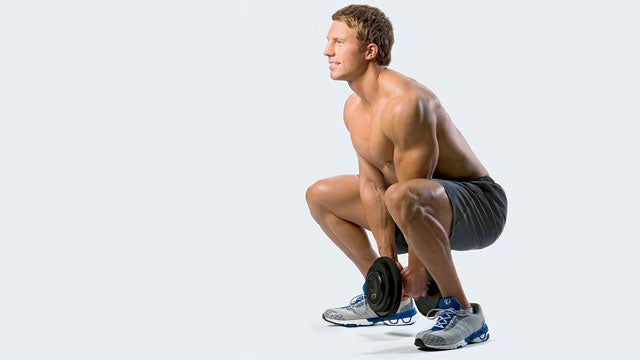A trainer I've been┬áworking with keeps a running list of her clients' fitness goals on her gym's whiteboard. Last January, I showed up to find “The Perfect Squat” written next to my name. “You have the flexibility of a 60-year-old,” she'd told me on an earlier visit. Apparently, this was my prescription.
It seemed like a joke. I spend most of my time experimenting with cutting-edge fitness routines and new training technology. Yet here I was, challenged to do a single, textbook repetition of a classic exercise, one I'd long ago relegated to beefy defensive linemen and World Cup skiers. What was one squat supposed to do for a 42-year-old weekend warrior like me?
The squat is sometimes called the “king of exercises” because of its exceptional ability to improve speed and strengthen lower-body, back, and core muscles. One 1998 study, published in the Journal of Orthopaedic & Sports Physical Therapy, found that a six-week squatting regimen improved vertical-leap height 10 percent more than a similar routine of leg presses and extensions. “This is one of the fundamental human movements,” says , 62, a functional-conditioning expert who's helped train the Chicago Bulls and U.S. Men's World Cup Soccer Team. “Squats really build your glutes, your primary shock absorbers. A lot of people don't realize just how much of their athletic activity involves slowing down, rather than just pushing off.”
My trainer, Carolyn Parker, insisted that I perform one perfect “air squat,” which entails sinking down until your thighs are parallel with the floor, then standing back up, without a weight bar on your shoulders. It isn't nearly as easy as it sounds. Unless your form is perfect, you won't get the full benefits of the motion and you can hurt yourself. To ensure that I didn't cheat, Parker had me face a wall, just three to four inches from my nose, feet spread a little more than shoulder width apart. To help with balance, I grasped an 18-pound kettlebell so that it hung between my thighs.
I tried to lower the kettlebell to the ground while keeping my heels on the mat, knees over my toes, and my lower back arched. But the motion forced me to bend forward at the waist until my face smeared against the wall, leaving a snail trail of snot.
“You're allowed to tilt your head back,” Parker said. But it didn't help. I kinked to a stop less than halfway through. When I tried again, I fell over backwards. “Whew,” she sighed. “We have a lot of work to do.”
Parker put together a twice-weekly routine consisting of several variations of the move, and I diligently practiced the wall squats. At some point I realized that I wasn't just trying to squat right; I was trying to undo nearly 20 years of not squatting. Two decades as a desk jockey, mostly ignoring good posture, had effectively reversed the curvature of my lumbar spine and inhibited blood flow to my entire pelvic region. Not only had this shortened and weakened muscles and tendons throughout my lower body and back, it had compromised circulation necessary to recover from my stressful workweeks and high-intensity soccer games, races, and weekend adventures. I realized I was a disc injury waiting to happen and flung myself into my workouts with a gusto worthy of Jack LaLanne.
A few months later I went to the gym, warmed up, faced the wall for my Perfect Squat attempt, and lo! touched the kettlebell to the ground. “Nice job!” Parker exclaimed. I was psyched, but I was even more pleased that my skiing had improved and my quickness and agility on the soccer field had cranked up a notch. I still can't bend it quite like Beckham, but even the king of exercises can't fix everything.
Squat Circuit Instructions 
Work these moves into your strength training once or twice a week. Do two sets of ten for each.

1. Target Squats: Starting in a squat position, use a two-handed chest pass to throw a medicine ball at a target ten feet up on a facing wall. Drop into a squat as you catch the ball.
2. Depth Squats: Hold a straight stick or unweighted bar across your upper back and shoulders. With feet a little more than shoulder width apart, lower as far as you can, taking care not to round your back. Keep your heels on the ground, knees above your toes, and look straight ahead, not up.
3. Split Squats: With dumbbells hanging in each hand, drop into a lunge position on your forward leg; do ten on each side.
4. Wall Squats: See story. You can use a dumbbell instead of a kettlebell.


